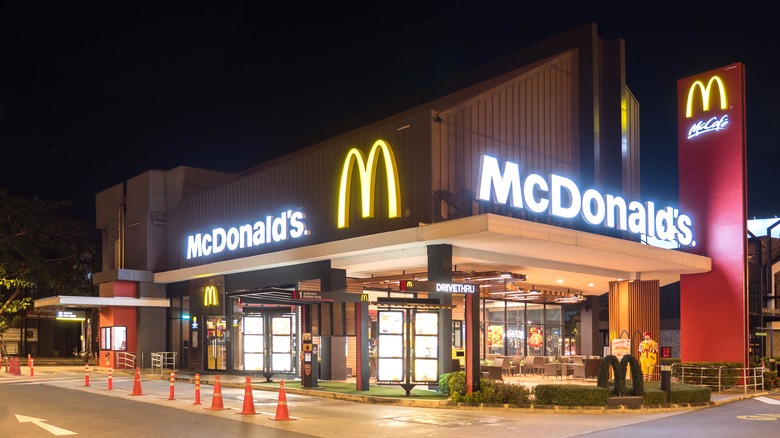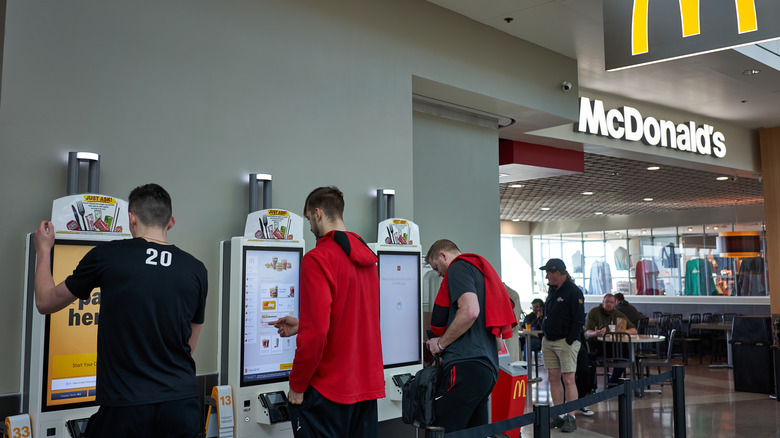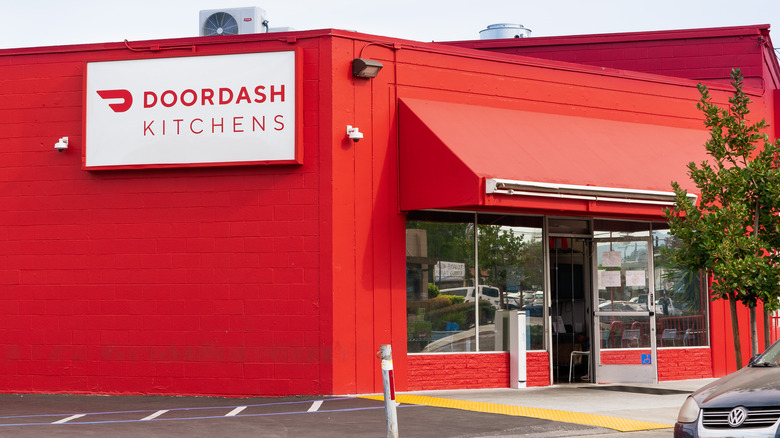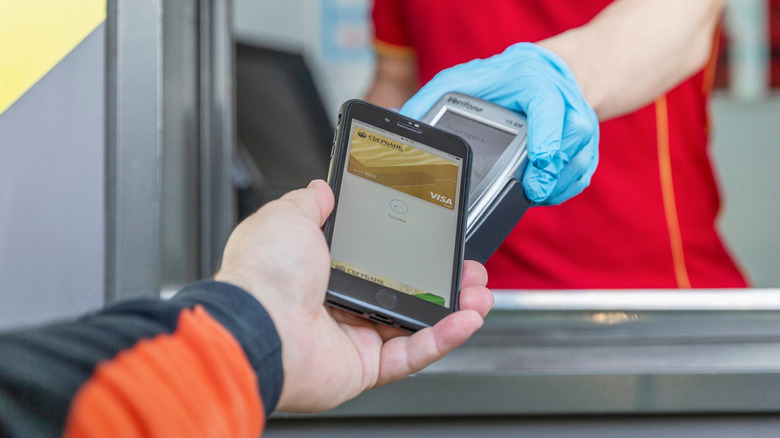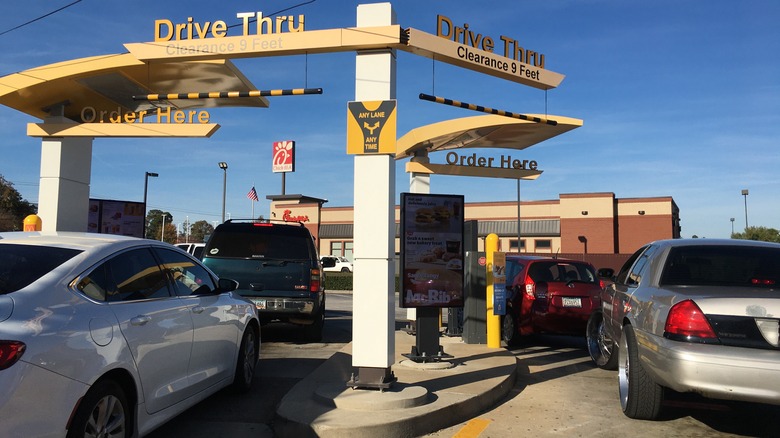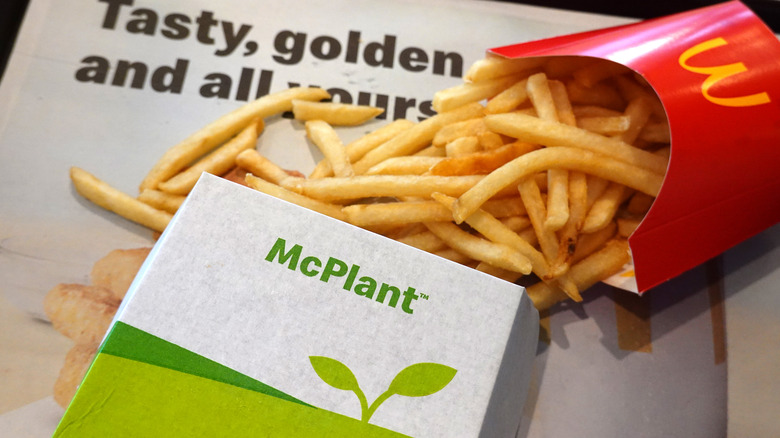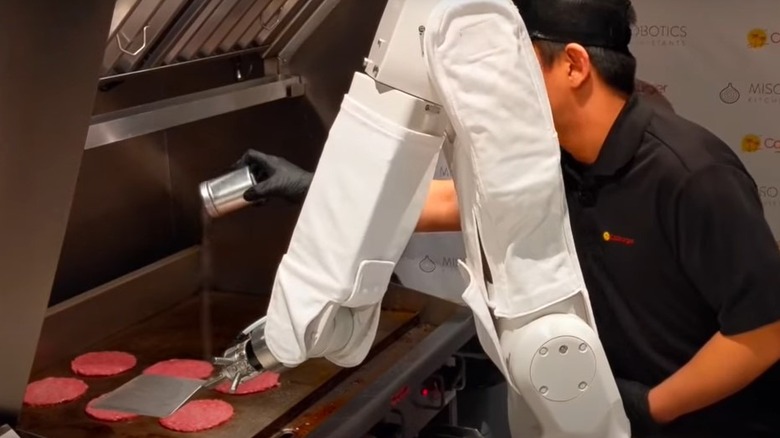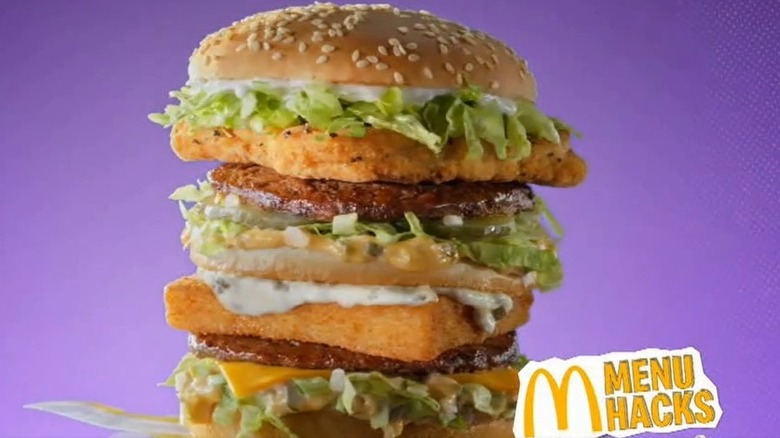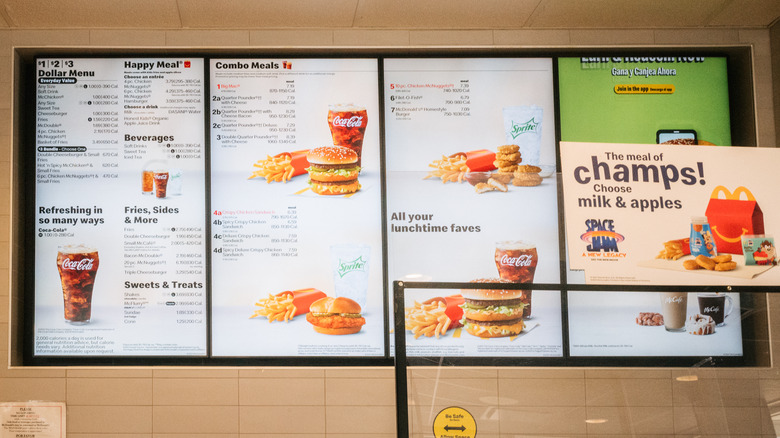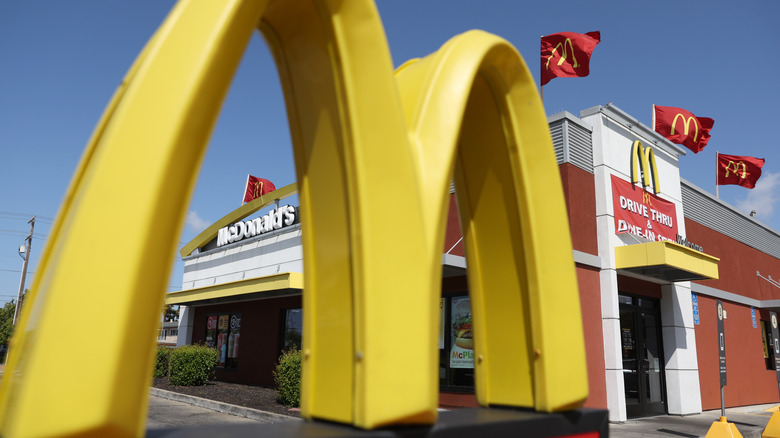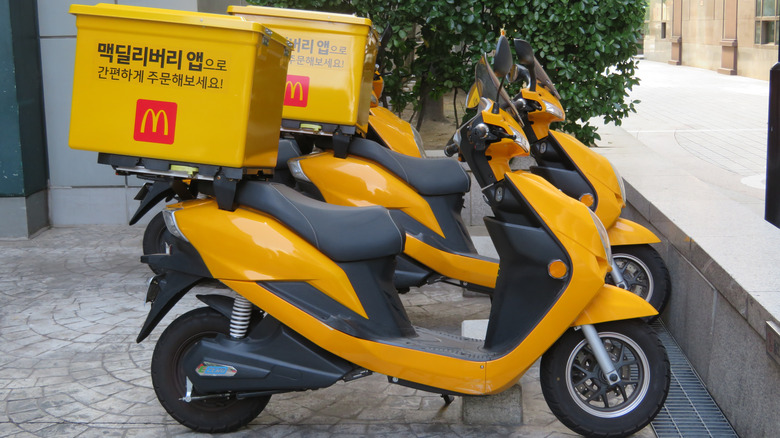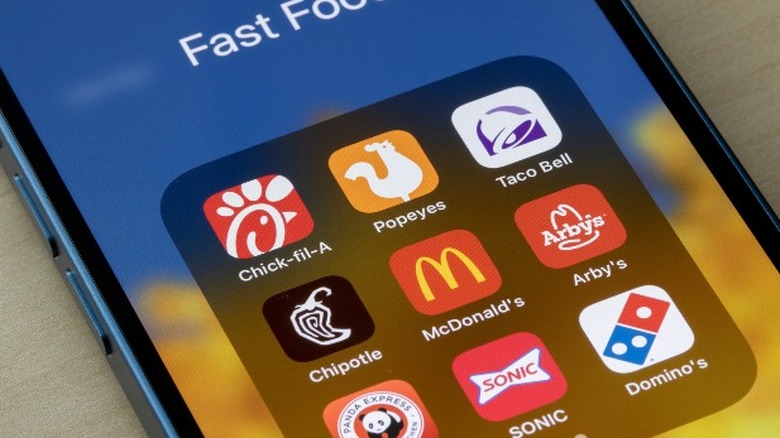What The McDonald's Of The Future May Be Like
Say the words "golden arches," and there's little chance a person won't immediately imagine the McDonald's logo. After all, the corporate trademark that adorns every store location throughout the world — beckoning to hungry customers like a siren song — is a nearly unrivaled symbol of Americana. Mickey D's reigns supreme over all other fast-food restaurants and was the top-selling chain in the U.S. in 2018. It reported nearly double the total sales of the second-place finisher.
Frankly, there's little reason to doubt diners won't still be lovin' it for years to come. But what will that look like, exactly? Will restaurants start to resemble the world of the futuristic cartoon "The Jetsons," which was set in the now-relatively near future of 2062? Unfortunately, no. More likely, if history is any indication, the McDonald's of the future won't be drastically different than it is in 2022. Sure, we can look forward to some intriguing innovations in the future. But at the same time ... well, we've already begun to see a number of ways the restaurant is likely to evolve.
From the rise of automated ordering and cooking to an increasingly streamlined set-up for employees and customers, we have some idea of what to expect from a future McDonald's. You won't need roads where we're headed, but you won't need a DeLorean either. Just a willingness to read on and discover what McDonald's of the future may look like.
You may not interact with many actual employees
Depending on who you ask, the reduction of genuine human interaction, alongside the rise of technology, is either a wonderful thing or an omen for the end of humanity. Of course, the reality of a situation like this, or any other, is that no matter where you stand on the issue — in this case, the direction of human advancement — time never stops marching on. For McDonald's, the plan to entice and retain customers in the future involves using digital technology to maximize their experiences, according to a corporate growth plan released in 2017.
In other words, if you're the type of person who laments the rise of machine-automated transactions, such as self-checkout lines, well ... you're likely out of luck. Because even if you are able to speak to someone at a McDonald's in the future, there's a decent chance you still won't be speaking with an actual employee, but rather a fully-automated, voice-based AI program designed to seem a real person (via QSR).
To be clear, the odds of all employees being eliminated from any restaurant — not just McDonald's — appears exceedingly low, at least in the near future. This is good. Because we've all seen the "Terminator" films and know that we need to retain some control over the robotic fleet to ensure we don't go down that road.
Ghost kitchens may replace physical locations
Have you ever found yourself scrolling through a food delivery app, unsure what to eat, and suddenly come across a restaurant option that isn't, in fact, a restaurant? Well, it is a restaurant, of course, only with food prepared at a ghost kitchen, a remote location that makes brand-specific, restaurant-quality food exclusively for delivery. Ghost kitchens — which, according to London-based research firm Euromonitor, could become a trillion-dollar business by 2030 (via Restaurant Dive) — have become all the rage in recent years. And this trend hasn't been lost on McDonald's, which has started, and is likely to continue, opening ghost kitchen locations in lieu of traditional, brick-and-mortar spots.
Now, there's no denying the need for social distancing during the COVID-19 pandemic expedited the process of businesses transitioning away from actual restaurant locations. But it's possible, if not entirely likely, that ghost kitchens would've risen in stature with or without those unprecedented, unforeseen challenges. After all, McDonald's actually opened its first ghost kitchen in October 2019 in London (via Property Week). That was months before most of the world had ever even heard of the coronavirus.
We're not fortune tellers by any means. But we're confident in predicting that McDonald's of the future may look like a kitchen — sans the actual restaurant, dining room, or garish decorations.
It may be exclusively digital or contactless payments
Whether it's a preference for the ease of going cashless or concern about dealing with dirty bills, the use of paper currency has been in decline since 2012 (via Axios). While it's unlikely cash will ever completely disappear from circulation in the U.S., it's safe to say McDonald's is prioritizing contactless payments over other more traditional methods, instead choosing to emphasize what it has dubbed the three D's: Digital, Delivery, and Drive-thru (via Food Industry).
Contactless payment methods have existed for quite some time, of course, including card-not-present transactions and cloud-based payments (via FastCasual.com). And with so many people eager to use contactless methods to pay for everything, there's only one real direction the restaurant can go moving forward.
You may not need to take the drastic step of burning any and all cash in your possession. Actually, we implore you not to do that, because we're not implying cash is on the verge of obsolescence. But if you're wondering what McDonald's of the future may look like, you may want to make things easier on yourself and plan for digital payment.
Drive-thru lanes may entirely usurp dine-in seating
Fast food restaurants have been shifting their focus towards mobile and drive-thru orders for years, even before a pandemic caused a need to socially distance — not only reducing consumers' desire to dine at a restaurant, but severely restricting that entire option. This includes McDonald's, which announced in November 2020 that it was planning to test restaurant locations designed exclusively for drive-thru or takeout orders (via Food Industry), offering no dine-in options whatsoever.
Frankly, whether or not McDonald's was eager to embrace this concept is unclear. But with so many customers now preferring to eat any and all meals from the comfort of their own home, the bottom line is companies have little other choice. As Danny Klein, director of digital content at QSR Magazine, told CNET in 2020 that "everyone is rushing to ... a focus on off-premise business instead of dine in." There's little reason to believe this won't continue at McDonald's of the future.
Maybe you miss the days of dining inside a McDonald's or frolicking around a PlayPlace. If you're one of those folks, our advice would be to make the most of that opportunity while you still can.
Plant-based alternatives may exist for every menu item
It's hard to imagine that the ascent of plant-based protein alternatives to meat, with perfectly mimicked flavors, will slow down anytime soon. Given that, it won't come as a surprise that the McPlant burger — which has been tested in locations around the U.S. since early 2022 — is likely to be joined by similar plant-based options for other McDonald's menu items in the future.
While the McPlant has yet to debut nationwide, like the Impossible Whopper has at Burger King, the company partnered with Beyond Meat in 2019, patiently crafting the highest-quality plant-based burger. And, by extending its partnership with Beyond Meat for an additional three years in 2021, McDonald's made clear its intention to continue its plant-based expansion beyond a single burger.
With an eye toward offering plant-based substitutions for both chicken and breakfast sausages, it's only a matter of time before the entire McDonald's menu is available in meatless varieties. Rather than resist, we're ready to gorge on any and all future options.
New restaurant designs and equipment may reduce its carbon footprint
If there's one thing corporations are loath to do, it's spend money they don't have to spend. Actually, most companies hate spending money they do have to spend. But that's just capitalism, we suppose. Anyway, with this in mind, when we see a company choosing to spend funds in an effort to combat the relentless impact of climate change — whether by altering its practices or replacing equipment — it warms our hearts (but not the planet). This is the case with McDonald's, which has taken steps to achieve net zero emissions company-wide by 2030 (via McDonald's).
Clearly, the process of McDonald's obtaining net zero emissions is ongoing. But the company appears to be on the right path, having opened its first net zero carbon restaurant in England in January 2022 (via ZDNet). This location recycled and repurposed certain items from an old location to reduce waste, presumably replaced out-of-date equipment with more efficient models, and installed solar panels and wind turbines to offset its energy consumption. This is a model the company hopes to eventually implement at every store.
Quite frankly, science doesn't lie. While some may prefer we simply trudge ahead with business as usual — planet Earth be damned — other potential difference-makers are hoping to ameliorate potential future damage by reducing their overall carbon footprint.
Employees may mainly activate robotic equipment when working
More than likely, the image of someone with their finger on a button generates nuclear bomb-based panic in many individuals. But, for employees at McDonald's in the future, the idea of having a finger on a button or two may just be part of the job. After all, someone has to start, and then supervise, the robot workers of the future — those capable of cooking burgers, fries, and everything else on a fast-food menu.
While the implementation of robotic equipment in McDonald's may not eliminate the need for all human workers, it's unknown if it will result in a reduction of the total number of human employees needed. Of course, the idea of having all humans phased out of McDonald's kitchens is something we should hope to avoid because our relationship with food is intimate and personal, said Max Elder, research director for the Food Futures Lab (via CBS8). That's an assessment we tend to agree with.
Chances are this particular development will occur farther into the future than any other prediction, given the financial issues between McDonald's corporate offices and franchisees regarding technological upgrades (via Restaurant Business). Not only that, but concerns may also exist surrounding the overall quality and cost of the actual technological advancements McDonald's has made in recent years, according to ZDNet. That means we may need to wait some time before this becomes a reality.
You'll have the ability to customize or mix-and-match any items
The existence of menu hacks at big chain restaurants is nothing new, and there are no shortage of secret menus at various quick-service joints throughout the U.S. Of course, it's unclear if the recent rise in individuals wanting to customize their orders is a result of modern Americans believing they're entitled to whatever they want, whenever they want. But it is clear that the ability to mix-and-match items at McDonald's is unlikely to be limited to the short-lived Menu Hacks promotion from early 2022 (via CNN).
Frankly, just how successful the Menu Hacks marketing campaign was is debatable. If we were betting folk though — which we're not, but to each their own — we'd put money on menu hacks and almost limitless options for customization only becoming more common at McDonald's in the future. After all, the company recognizes it can't take its customer base for granted and has prioritized an enhanced customer experience overall, which limits the restrictions it can consider imposing on its menu.
Interestingly enough, the popularity of secret menus and Franken-foods can be consider contradictory, according to Alice Julier, a sociology professor at Chatham University. She told The Washington Post in 2022 that these menu items may seem shrouded and unavailable, but most are derived from options that are widely available.
There may be less overall choices on the menu
What a restaurant chooses to sell on its menu is critical to the potential success of that restaurant. Well, of course it is. After all, if a restaurant sells inedible or improperly prepared food, it won't stay in business very long. But it's not just what a restaurant sells that matters. Ensuring quality, perhaps over quantity, is also of monumental importance. That may be why the odds favor McDonald's of the future offering fewer overall items on its menu.
McDonald's hasn't always adhered to a less-is-more approach when it comes to its menu. But amidst the COVID-19 pandemic, it was forced to trim its offerings, to the delight of many franchisees (via Fox Business). After all, the bigger a menu, the more work involved across the board for a restaurant. Yet by aiming to keep its menu lean and mean, McDonald's provided individual restaurants and employees the chance to focus on doing a few things well, rather than a lot of things ... not so well.
Not all consumers were thrilled with all the changes spurred by the pandemic. In particular, the end of all-day breakfast still stings (via CNBC). That development is made worse considering the decades spent waiting for McDonald's to serve all-day breakfast in the first place. Unfortunately, as of this writing, the restaurant has yet to bring back all-day breakfast nationwide, according to USA Today.
It may not resemble any McDonald's you're used to
We don't mean to imply McDonald's would ever even consider changing their famous logo or do anything to that iconic pair of golden arches. But just as restaurants have changed and evolved compared to 50 years ago, the appearance of a McDonald's restaurant — and all fast-food restaurants, for that matter — will almost certainly change in the future from what consumers have come to expect.
It's not just the reduction in dining room space that will change the look of McDonald's in the future. Nor is it just the potential increase in the number of drive-thru lanes from the standard single lane. Let's not even address the sight of a McDonald's ghost kitchen, since the only people that may look familiar to would be current and ex-employees of Mickey D's.
In all honesty, will McDonald's look like some sort of sleek, sci-fi facility ready for intergalactic customers? Not any time soon. But if you're used to seeing the golden arches above white lettering on a red sign, with an enormous PlayPlace connected to the restaurant, you may be surprised by what you see in the future.
Delivery may become the main source of sales
If you came here looking for mind-blowing predictions about potentially futuristic advances from McDonald's, we're sorry if we've disappointed you. Frankly, one of the best ways to find hints regarding the McDonald's of the future is to look at the restaurant today. That leads to the fairly easy conclusion that delivery could very well become its main source of sales in the future.
One reason for this likelihood is that the number of ghost kitchens attached to well-known brands, such as McDonald's, is only likely to grow during the next decade, according to Restaurant Dive. With potentially fewer dine-in options, the percentage of delivery orders will increase in turn.
Additionally, the consumer demand for convenience in all walks of life has already kickstarted this process in recent years. After all, an increase in deliveries ordered, across all demographics, wasn't solely a result of the COVID-19 pandemic (via QSR). That trend is all but certain to keep trending upward in the future.
Separate menus may exist for delivery and in-person ordering
The way of the world means that, at some point, every restaurant will be forced to offer delivery in some capacity, regardless of its culinary niche. That is if they don't already. Frankly, thanks to GrubHub, Uber Eats, and DoorDash, the vast majority of restaurants are already offering delivery in 2022. This is true of fast-food chains like McDonald's, of course, which, in the future, may even contain separate menus — one for ordering at the restaurant and another for ordering delivery.
We think it's fair to say the fast-food conglomerate hasn't exactly perfected the art of food delivery. Not that this is a criticism, per se. More than anything, it's an indication that the menu items offered, and then prepared, may not be ideally suited to the delivery process. But there's hope. One of the best ways a restaurant can improve the quality and consistency of its deliveries is to highlight menu items best suited for travel (via Escoffier School of Culinary Arts) — possibly through the creation of a menu dedicated solely to delivery.
Additionally, the specific packaging used by McDonald's may slightly change in the future. Because, not unlike separate menus being offered, the company seems willing to do whatever it takes to ensure it leaves its billions of customers satisfied — now and into the future.
